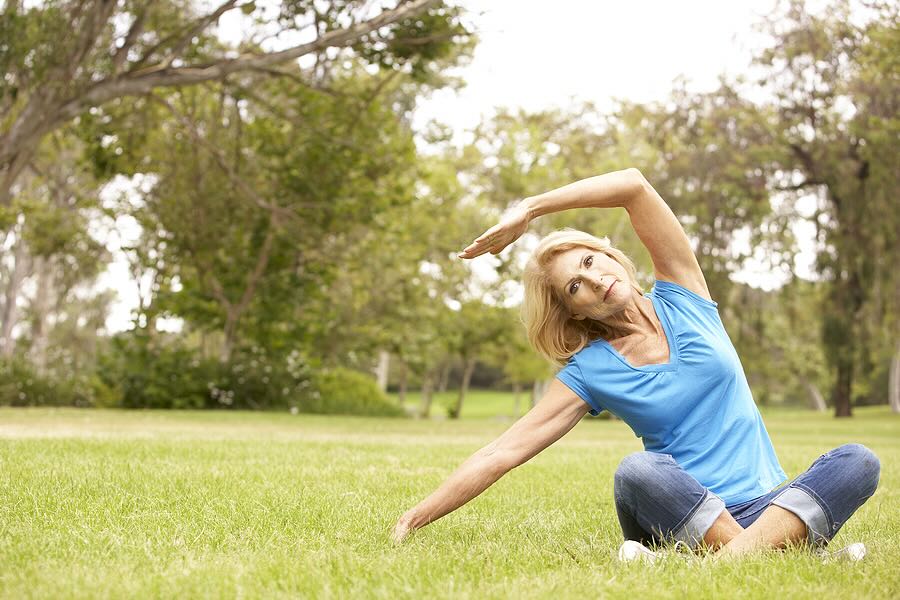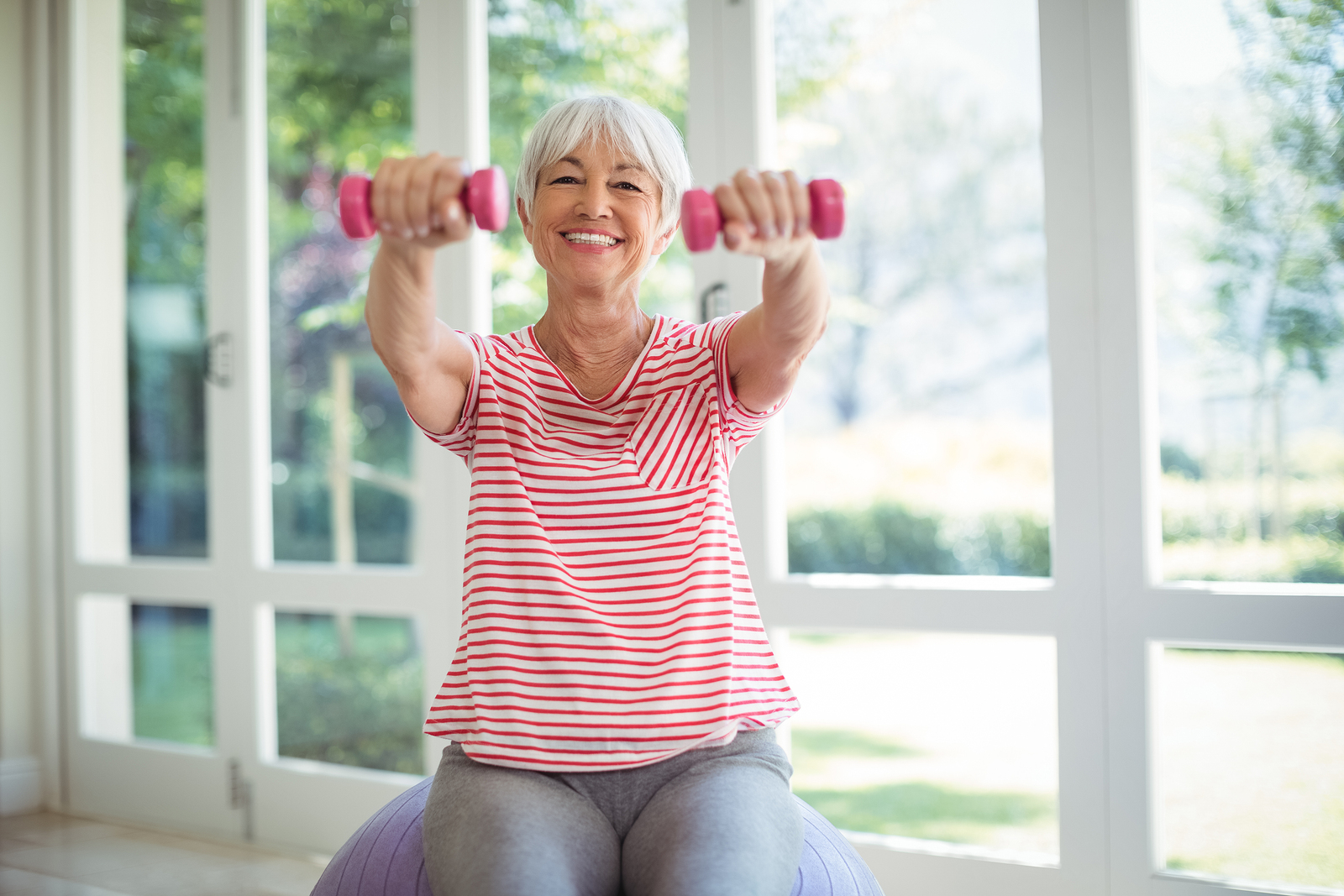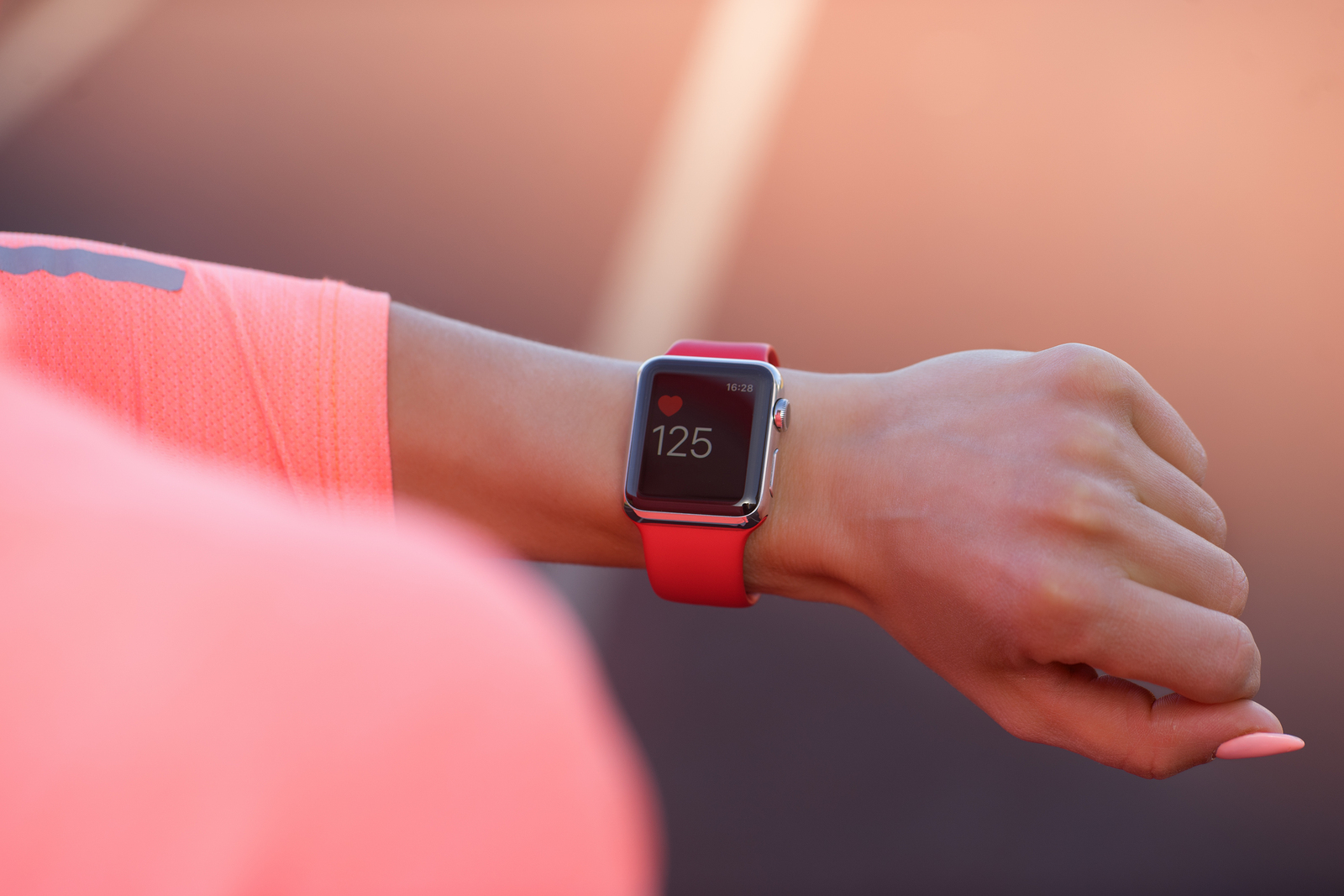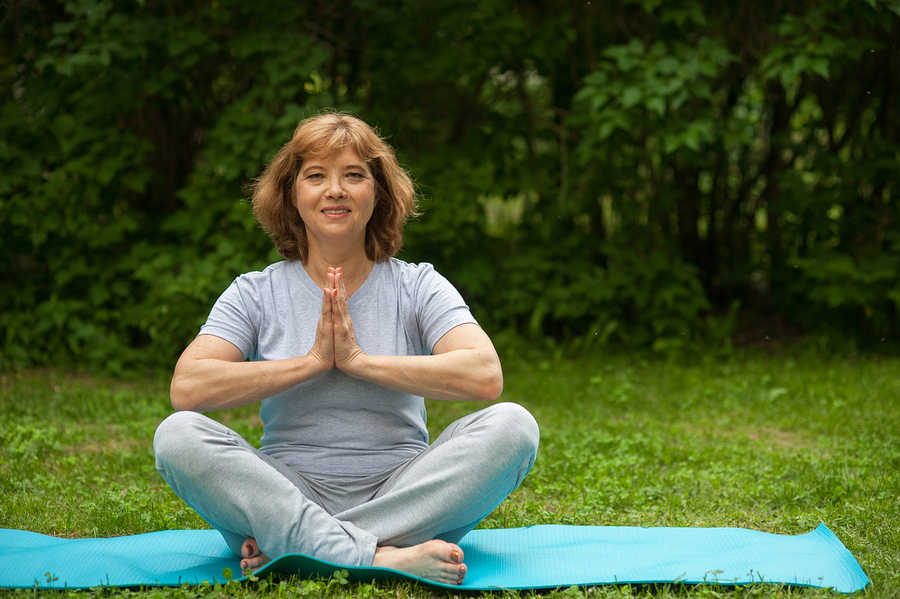Can you guess the healthy habit my patients find the hardest to follow? It’s regular exercise. Despite their best intentions, most of my patients allow exercise to fall by the wayside when life gets busy or stressful — which is all the time, right?
But there is a way to begin, or renew, your commitment to physical fitness; it’s something that should come easily to every woman because you have to do it anyway.
The Secret Is Simply To Breathe… Deeply and Often
Whether you are currently exercising or not, think about how your routine could be enriched by paying more attention to your breath. Mindful exercise that synchronizes movement and breath has the power to change more than how you look.
In a 2005 review and analysis of several studies, Richard Brown, MD and Patricia Gerbarg, MD reported that yogic deep-breathing techniques were extremely effective in handling depression, anxiety, and stress-related disorders. These techniques can serve as an excellent adjunct to conventional medical treatment — or in some cases as a suitable substitute — for myriad psychological disorders, as well as eating disorders and obesity.
I have noticed that a surprising number of my patients show irregularly high levels of carbon dioxide in their blood. Interestingly, the carbon dioxide level is often abnormal when all other blood tests are fine. In fact, I probably see more abnormal tests for carbon dioxide than for standard glucose, kidney or liver tests.
While this is not life threatening, it does tell me that my patient is not inhaling enough oxygen or exhaling enough carbon dioxide, which can have consequences such as fatigue, mental fog and decreased tissue function. I often note “needs to breathe” on a patient’s chart. And I don’t mean the shallow chest breathing many of us default into; I’m talking about deep, meaningful breaths, or “belly breathing.”
Let’s discuss why and how you should learn to breathe for your health.
Breathing For Health
At the Women to Women Health Care Center, many patients come through the doors knowing that diet and exercise form the cornerstone of good health. They want to “be better” about going to the gym but just can’t seem to stick with their exercise plan for more than a month or two. Most of my patients find it much easier to change their diet than their physical activity levels because they have to find time to eat — not so with exercise.
One of the reasons aerobic exercise is good for you (and is so good at clearing away mental cobwebs) is that it increases your heart rate and forces your lungs to take in more oxygen while expelling more carbon dioxide. This gives your heart a good workout — it is a muscle after all — and pumps a quick jolt of oxygen through your cells, even those that may have been operating at reduced capacity.
Shallow breathing (or chest breathing) causes a constriction of the chest and lung tissue over time, decreasing oxygen flow and delivery to your tissues. Deep, rhythmic breathing expands the diaphragm muscle, the cone-shaped muscle under your lungs, expanding the lung’s air pockets, invoking the relaxation response, and massaging the lymphatic system.
Stimulating the Lymphatic System
Breathing serves as the pump for the lymphatic system, just as the heart serves the circulatory system. Your cells must have oxygen to survive moment to moment. To thrive, they rely on a complex exchange between the circulatory system and the lymphatic system. Blood flow carries nutrients and ample amounts of oxygen into the capillaries, while a healthy lymphatic system carries away destructive toxins. Proper breathing is the moderator of this exchange.
We don’t often think about our lymph nodes unless we hear about someone with cancer, which is surprising, because we have twice as much lymphatic fluid as blood in our bodies.
How the lymphatic system works
So what is the lymphatic system? It could be likened to the body’s sewer system. Lymph vessels form a drainage system throughout the body. Our cells swim in an ocean of lymphatic fluid that carries away the detritus of our immune system, including dead white blood cells, unused plasma protein and toxins.
It works like this: blood is pumped around the body by the heart, transporting nutrients and oxygen to the cells. Once the cells have absorbed what they need, they excrete debris and toxins, which then get flushed and deactivated by lymphatic fluid.
The lymph fluid then drains into the circulatory system through two ducts at the base of your neck (the thoracic duct), and becomes part of the blood and plasma that pass through the kidneys and liver. But unlike your circulatory system, your lymph system does not have a built-in pump. It relies on the act of breathing and bodily movement to move all that waste fluid around.
The consequence of a sluggish lymphatic system is that you cannot detoxify properly. And if you aren’t breathing deeply or moving regularly, chances are your lymph fluid is not flowing as well as it could. As you can well imagine, this can lead to health concerns over time, including weight gain, muscle loss, high blood pressure, fatigue, and inflammation.
But the great news is that you can improve your lymph system cleansing by learning to practice deep breathing. The expansion and contraction of the diaphragm actually stimulates your lymphatic system and massages your internal organs, helping the body rid itself of toxins, and leaving more room in the cells for an optimal exchange of oxygen.
And while you are helping your body to clean house, you’ll also be fighting stress.
Breathing Exercises and The Relaxation Response
Deep breathing is the fastest way to trigger your parasympathetic nervous system, through what some practitioners call the relaxation response. Further review and analysis of research by Drs. Brown and Gerbarg resulted in the development of a new neuropsychological theory for how yogic breathing may affect the stress response system and calm the mind and body. Their article in Current Psychiatry showed how trained deep breathing can relieve trauma symptoms.
The sympathetic nervous system, which is stimulated in times of stress and anxiety, controls your fight or flight response, including spikes in cortisol and adrenaline that can be damaging when they persist too long.
As many of you know, chronic stress depletes the body of nutrients and destabilizes brain and endocrine chemistry. Depression, muscle tension and pain, insulin sensitivity, GI issues, insomnia, and adrenal fatigue are among scores of other conditions all related to an overworked sympathetic nervous system. What counteracts this mechanism? The parasympathetic nervous system.
Breath is the fastest medium by which these systems can communicate, flicking the switch from high alert to low in a matter of seconds.
Countering stress through deep breathing
When someone is frightened or stressed, they tend to hold their breath or take rapid, shallow breaths. The heart pounds and muscles clench as the adrenaline kicks in. For more on this see our articles about anxiety. When the stressor is resolved, they let out a deep breath, signaling the brain that everything is okay again. If deep breathing continues, the heart rate decreases, the lungs expand and the muscles relax. Equilibrium is restored.
Many Eastern cultures have long recognized the importance of breathing to cultivate a positive relationship between the body and the mind, one that results in a more tranquil state of being and a more resilient physiology. Yoga, qi-gong and t’ai chi are such healthy practices in large part because they combine deep breathing and movement to support a steady central nervous response.
This provides at least a partial clue as to why Asian women report fewer menopausal symptoms, including hot flashes. Several studies on women during the menopausal transition show that paced breathing and other relaxation techniques reduce both frequency and severity of hot flashes. This is noteworthy because there are no adverse effects to deep breathing!
And this is also important when you are trying to lose weight and burn fat.
Weight Loss and Deep Breathing — Aerobic and Anaerobic Exercise
Deep breathing delivers many of the benefits of exercise, including facilitating weight loss. Though not a substitute for exercise, it’s a great first step for women just beginning an exercise plan, and deep breathing enhances the benefits of any form of exercise. Let’s look at how these effects take place and their relationship to weight loss.
One basic measure of fitness is cardiovascular capacity — how much oxygen our hearts and lungs can deliver to our cells. When muscle cells spring into action, they must have energy to burn and the waste products of that metabolism removed.
When our cardiovascular system can keep up with those demands, the exercise is said to be aerobic. When the demands of the exercise exceed our cardiovascular capacity, the exercise is anaerobic, and the metabolic steps change, so the cells begin tapping energy stored in the form of glycogen. But once the accumulated toxins reach a certain point, the muscle can’t keep working, and we “hit the wall.”
Aerobic or low-demand exercise has many health benefits. But anaerobic exercise is especially good at raising the capacity of the cardiovascular system — hence the phrase, “no pain, no gain.” The good news is that deep breathing also helps raise that capacity.
Another virtue of aerobic exercise is that it burns fat for energy rather than using up the cells’ energy supplies — an essential element in weight loss. We believe that deep breathing encourages the burning of fat even in low-demand activities. And don’t forget — whenever you are stressed, your body tends to burn glycogen, not fat, and through triggering the relaxation response, deep breathing encourages your body to burn fat instead.
So now that you know why breathing well is so important, let’s look at ways to practice it!
Breathing — The Truly Essential Exercise
What kind of breather are you — chest or belly, nose or mouth? Try this test: Place one hand on your chest and one hand on you abdomen. Take a normal breath while looking down. If the hand on your chest rises first, you tend to breathe in your chest. If the hand on your abdomen rises first, you are more of a belly breather.
To find out whether you are a nose or mouth-breather — if you don’t already know — just ask a friend, your workout buddy, or sleeping partner. Chances are, they’ve noticed if you’re a mouth-breather. Breathing through the nose is axiomatic to invoking the parasympathetic nervous system and the attendant relaxation response.
Take time to practice breathing
Whichever form of breathing comes naturally to you, the following breathing exercises can teach you how to breathe more fully. They don’t require a lot of time, but work best if you commit to practicing them for a few minutes every day. Over time, you will find that you are breathing more deeply throughout the day, even when you exercise — the best of both worlds!
If you think you can’t find time to practice deep breathing exercises regularly, take a deep resounding breath, then think again. The irony here is that women forget to breathe because they are so busy listing what they need to do for everyone else, yet deep breathing is something you can do just about anywhere while doing just about anything — while washing up, grocery shopping, commuting to work, listening to others, standing in the shower, or sitting in a meeting. If you must, post sticky-notes with the word “Breathe” around your house, your desktop or your steering wheel. Stoplights make a good mnemonic, too — fully exhaling and inhaling helps counteract road rage. The point is, breathing is something you simply must do — so make the most of it, and it in turn will serve you well.
Breathing Techniques
Simple Deep Breathing
The most basic thing to remember is that your breath begins with a full exhalation (I know this seems counterintuitive, but it’s true). You can’t inhale fully until you empty your lungs completely. It is also important to breathe in through your nose.
Now try this: Sit in a comfortable position with your hands on your knees. Relax your shoulders. On your next exhalation, breathe out slowly through your nose, counting to five. Tense your abdominal muscles, drawing in your diaphragm to help your lungs deflate. At the bottom of your breath, pause for two counts, then inhale slowly to the count of five. Expand your belly as you breathe in. Now close your eyes and repeat 5–10 times. Think of your diaphragm as the pump and your breath as the power.
If you find that your mind wanders during this exercise, don’t worry. Just refocus on your counting. Some of my patients find it helpful to think of a happy color (like yellow) when they breathe in and a droopy color (like grey) as they breathe out. As your awareness of your breath increases, you’ll find that it becomes easier to breathe deeply without so much attention.
The Bellows, or Fire Breath
Many forms of yoga begin with breathing techniques, or pranayama. Prana means ‘breath’ or ‘life force’ in Sanskrit. The bellows breath is a yogic exercise that stimulates energy when you need it, toning the abdomen and massaging the internal organs and lymph system. Though not deep breathing, the bellows does activate the lungs, neck, chest and abdomen so that deeper breathing comes more naturally.
Again, sit in a comfortable position. With your mouth closed, breathe in and out through your nose as fast as possible. Think of pumping up a balloon or water toy. Try to breathe in and out as equally as possible. Continue for 10–15 seconds, no more at first. As you become more accustomed to this technique you can increase the exercise to one full minute.
Three-part Breathing
This yoga technique is very useful during times of stress, or any time you need to relax. It is extremely relaxing and can be done before bed to assist with sleep issues.
Again, sit comfortably and close your eyes. With your mouth closed, exhale deeply through your nose. Imagine that you are pouring the breath out of a jug, starting at the top of your chest and moving down through your mid-torso and into your diaphragm. Pause for two counts at the bottom of the breath, then inhale through your nose. Refill the “jug” slowly, counting to five (or seven if you can make it). Start at the bottom, expanding your diaphragm and belly, then your mid-torso, and lastly the top of your chest and lungs. Pause for two counts and exhale as before. Repeat 5–10 times.
Other breathing resources
There are many other ways to begin practicing healthy deep breathing. Visit the Authentic Breathing website for additional exercises and information. Your local yoga studio or health club may offer classes in breathing awareness techniques. There are many good books on the subject, including Dennis Lewis’s The Tao of Natural Breathing and Conscious Breathing, by Gay Hendricks.
Breathwalk and Other Mindful Exercises
Many of my patients have had great success using breath to heal their health concerns with a program called BreathWalk. This is a comprehensive health care technique that combines rhythmic breathing with customized walking routines. Classes and special events are held in many states around the country. A BreathWalk plan can be tailored to meet your specific needs by matching your health concerns with their proven breath-walk combinations.
BreathWalk combines the everyday act of breathing with another activity the body is perfectly designed for: walking. Even if you don’t feel up to a daily slog to the gym or yoga studio, the benefits of deep breathing are multiplied when combined with any kind of physical exercise. Start slowly with a walk to the mailbox, or park your car a little farther away from the store than usual. Focus more on your breath, adding a bit more aerobic activity each day. If you feel tired or winded, rest a minute and breathe deeply. Then try a little more.
Once you have worked up your tolerance for walking, continue your deep-breathing routine but add two minutes a day to your activity level. If you can walk at a regular pace without fatigue or pain for 20 minutes, you may be ready to add additional aerobic or resistance training. Talk to your medical professional about what is safe for you.
Many local Y’s, community centers and health clubs recognize the importance of breathing and exercise. Classes in healthy techniques like Pilates and yoga are now standard fare. Taking it one step at a time with respect and consideration for your amazing and complex body will ensure that you enjoy a lifetime of exercise and wellbeing, not just a passing resolution.
Support your lungs and lymphatic system
And remember, your cells need more than just oxygen to function well. With this in mind, we have a few other recommendations to help support your lungs and lymphatic system in your body’s journey toward deep breathing and integrated physical fitness.
- First of all, if you smoke, try to stop now.
- Practice a gentle and supportive detox at least twice a year to give your kidneys, liver and lymphatic system a rest.
- Address any issues that may be interfering with your ability to take deep, sustaining breaths. Bacteria, viruses, overheated air and food sensitivities — especially to dairy — can inflame the nasal passages, creating excessive phlegm, which makes breathing through the nose difficult. Investing in a humidifier/air purifier may help you breathe more easily. (Just be sure to clean them regularly!)
- To naturally clear sinuses and nasal passages, the Neti pot has been in use in India for thousands of years. This Ayurvedic technique uses a small, long-spouted kettle filled with lukewarm water to gently irrigate the nasal passageways.
- Bouncing on a mini-trampoline or rebounder for five minutes a day will help you pump lymph fluid more efficiently.
- Keep breathing! Commit to taking five deep breaths a day for the next week. Then make it ten. If you start a daily practice of deep breathing, you may be surprised how much easier it will be to start an exercise routine.
- If you are mobile, start walking and breathing (in addition to your five deep breaths). Even 20 minutes a day can make a big difference in how you feel. Pump your arms and legs, breathe through your nose and smile!
Making Time For Yourself A Priority
I often tell patients, “Pay yourself first.” So often, women make time for everyone else, rising to meet the demands of others before they nurture themselves. Learning how to breathe more fully and deeply is a very small but vital way to honor yourself and your miraculous life. In many cultures and religions, breath is life — a divine connection to a force that binds us all to the ebb and flow of nature.
By taking a few moments in your day to really pay attention to the inhalation and exhalation that supports your life, you will slowly and surely move toward a healthier and happier place. Remember, small changes add up to big improvements — and what better way to begin than breathing?








